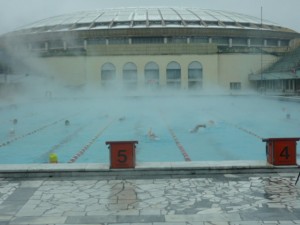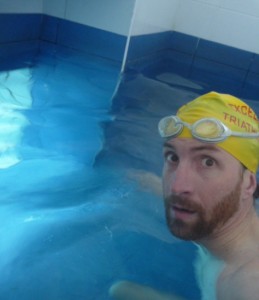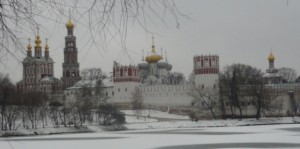It starts with the longest escalator rides you’ll ever take. Stand at the top, hit “play” on your iPod, and step forward for the steep ride down. While “Back in the USSR” pumps through your earbuds – all two-and-a-half minutes of it – you’ll see an endless line of Muscovites ascending. Expressionless faces, white in the lights, contemplating the day ahead. Sometimes you make eye contact – two seconds – before continuing your downward glide. Ringo Starr hits the cymbal one last time and the song ends, but the escalator still has half a minute to go. No one’s talking except the pre-recorded voice cautioning against some possible hazard.
The descent is controlled, requires no action. But arrival at platform level demands decisive motion. Pick a direction, go forward, don’t stop. Behind you, everyone knows exactly where they’re going and you can hear fast-paced clicking of stilettos on marble – Moscow’s ladies are fearless in heels. The commuters don’t rush but the pace is brisk. You’re deep in the commuter stream, which crashes into counter currents from right and left as trains disgorge their passengers. Even off-peak hours are crowded here in Moscow, which has one of the biggest subway systems in the world and up to 9 million daily users.
motion. Pick a direction, go forward, don’t stop. Behind you, everyone knows exactly where they’re going and you can hear fast-paced clicking of stilettos on marble – Moscow’s ladies are fearless in heels. The commuters don’t rush but the pace is brisk. You’re deep in the commuter stream, which crashes into counter currents from right and left as trains disgorge their passengers. Even off-peak hours are crowded here in Moscow, which has one of the biggest subway systems in the world and up to 9 million daily users.
On the platform, a gust of air precedes the train out of the tunnel, and it rumbles in with a loud, descending yell. The older carriages are battered, painted dull blues and grays. The doors slide open with a hydraulic “Pffff!” and the wagons exhale their passengers, then inhale the people standing on the platform. At busier times, it’s elbows-up getting in, pressing forward. At full capacity, arms pinned in front, people squeeze together, eyes averted. The doors close emphatically, like a horizontal guillotine. Don’t worry if you missed the train, another will be along in two minutes.
The train accelerates, rolling, swaying. If you’re standing, hang on. Unless you have a solid surfer’s stance, riding hands-free will bump you into those standing beside you. There are four types of passenger; the dozer, chin on chest, who usually has a seat. The listener, earbuds in, may have the Beatles playing. But there’s no way to know as the wagon’s loud metallic shrieks and thumping “duddum duddum duddum” drown out normal-pitched conversation. The reader has a glowing electronic device in front of his face, or a book held close. The thinker is most inscrutable – is she pondering the realities of dinner, the fantasies of travel? I also encounter some of the Metro’s more awkward riders; the amputated beggar, rolling on a makeshift cart; the passed-out red-faced drunk; the alcohol-urine stinking vagrant sucking on a beer while holding a greasy sausage in his dirty fingers.
As the train approaches the station, the passengers shuffle into position to get out or get out of the way. The wagons shudder to a halt, the doors slide open, and the whole kinetic human swirl begins again. The stations themselves are beautifully designed, unique but somehow tragic. Like art galleries which few among millions stop to appreciate as they press toward their next appointment. Perhaps Muscovites don’t take their Metro for granted, though. Perhaps they take comfort in knowing the loud, crowded underground is unique and it’s theirs.






